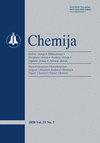Seasonal variation of the qualitative and quantitative composition of triterpenic compounds and antioxidant activity in vitro in the apple extracts of cultivars grown in Lithuania
IF 0.4
4区 化学
Q4 CHEMISTRY, MULTIDISCIPLINARY
引用次数: 0
Abstract
2 Institute of Horticulture, Lithuanian Research Centre for Agriculture and Forestry, 30 Kauno Street, 54333 Babtai, Kaunas District, Lithuania Apple (Malus domestica Borkh.) fruits are rich in phenolic glycosides, triterpenic acids and other biologically active compounds. The apples are widely used as food products due to their biologically active compounds that have specific biological effects. It is important to use high quality apples or their recycling products, so it is necessary to investigate the qualitative and quantitative composition of the bioactive compounds. The amount of triterpenic acids varies during different phenological stages of apple development and maturation. In order to determine in which phenological stage of apple growth the quantity of triterpenic acids was highest, high-performance liquid chromatography was applied. The highest total amounts of triterpenic compounds were detected at the beginning of the phenological stage of fruit development. The study showed that the highest amounts of triterpenic acids were detected at the beginning of the phenological stage of apple development, while as the apple matured, the amount of triterpenic acids decreased from 2.63 ± 0.26 mg/g to 1.6 ± 0.28 mg/g. In this study, we identified and quantified four triterpenic compounds, which by the quantitative composition of triterpenic acids could be arranged in the following ascending order: betulinic acid < corosolic acid < oleanolic acid < ursolic acid. In order to use herbal extracts for medical practice it is important to perform biological effects study in vitro and in vivo. Antioxidants with different mechanisms of action neutralize harmful reactive oxygen and nitrogen forms and enhance antioxidants protection systems. The antioxidant activity of apple extracts in vitro varied during different phenological stages of the fruit. The strongest antiradical and reductive activities were observed at the beginning of apple development. In order to determine the relationship between the antioxidant activity of the acetone extracts of apples assessed by DPPH, ABTS, CUPRAC and FRAP assays and the total amount of triterpenic acids in these extracts, a correlation analysis was carried out. The strongest positive correlation was observed between the amount of oleanolic acid and the antioxidant activity assessed by DPPH, ABTS and CUPRAC methods (respectively, r = 0.778, r = 0.784 and r = 0.720).立陶宛栽培品种苹果提取物中三萜化合物定性和定量组成的季节变化及体外抗氧化活性
2 .立陶宛农业和林业研究中心园艺研究所,立陶宛考纳斯区考诺街30号,54333 Babtai,考纳斯。苹果(Malus domestica Borkh.)果实富含酚类苷、三萜酸和其他生物活性化合物。苹果被广泛用作食品,因为它含有具有特定生物效应的生物活性化合物。利用优质苹果及其回收产品是重要的,因此有必要对其生物活性成分进行定性和定量研究。三萜酸的含量在苹果发育和成熟的不同物候阶段有所不同。为了确定苹果生长哪个物候期三萜酸含量最高,采用了高效液相色谱法。三萜化合物总量在果实发育物候期初期检测到最高。研究表明,三萜酸含量在苹果物候发育初期最高,随着苹果成熟,三萜酸含量从2.63±0.26 mg/g下降到1.6±0.28 mg/g。在本研究中,我们鉴定并定量了四种三萜化合物,根据三萜酸的定量组成,它们的排列顺序为:白桦酸<花心果酸<齐墩果酸<熊果酸。为了将草药提取物用于医学实践,进行体内和体外的生物效应研究是很重要的。具有不同作用机制的抗氧化剂可以中和有害的活性氧和活性氮形式,增强抗氧化剂保护系统。苹果提取物的体外抗氧化活性在果实的不同物候阶段有所不同。在苹果发育初期,抗自由基和还原活性最强。为了确定DPPH、ABTS、CUPRAC和FRAP测定的苹果丙酮提取物的抗氧化活性与提取物中三萜酸总量的关系,进行了相关分析。DPPH法、ABTS法和CUPRAC法测定的齐墩果酸含量与抗氧化活性呈正相关(r = 0.778、r = 0.784和r = 0.720)。
本文章由计算机程序翻译,如有差异,请以英文原文为准。
求助全文
约1分钟内获得全文
求助全文
来源期刊

Chemija
化学-化学综合
CiteScore
1.30
自引率
16.70%
发文量
14
审稿时长
>12 weeks
期刊介绍:
Chemija publishes original research articles and reviews from all branches of modern chemistry, including physical, inorganic, analytical, organic, polymer chemistry, electrochemistry, and multidisciplinary approaches.
 求助内容:
求助内容: 应助结果提醒方式:
应助结果提醒方式:


